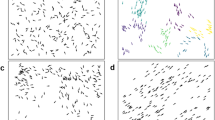Abstract
Collective behaviors are typically hard to model. The scale of the swarm, the large number of interactions, and the richness and complexity of the behaviors are factors that make it difficult to distill a collective behavior into simple symbolic expressions. In this paper, we propose a novel approach to symbolic regression designed to facilitate such modeling. Using raw and post-processed data as an input, our approach produces viable symbolic expressions that closely model the target behavior. Our approach is composed of two phases. In the first, a graph neural network (GNN) is trained to extract an approximation of the target behavior. In the second phase, the GNN is used to produce data for a nested evolutionary algorithm called macro-micro evolution (MME). The macro layer of this algorithm selects candidate symbolic expressions, while the micro layer tunes its parameters. Preliminary experimental evaluation shows that our approach outperforms competing solutions for symbolic regression, making it possible to extract compact expressions for complex swarm behaviors.
J. Smith—Independent Researcher.
Access this chapter
Tax calculation will be finalised at checkout
Purchases are for personal use only
Similar content being viewed by others
References
Birattari, M., Ligot, A., Francesca, G.: AutoMoDe: a modular approach to the automatic off-line design and fine-tuning of control software for robot swarms. In: Pillay, N., Qu, R. (eds.) Automated Design of Machine Learning and Search Algorithms. NCS, pp. 73–90. Springer, Cham (2021). https://doi.org/10.1007/978-3-030-72069-8_5
Brown, D.S., Turner, R., Hennigh, O., Loscalzo, S.: Discovery and exploration of novel swarm behaviors given limited robot capabilities. In: Groß, R., et al. (eds.) Distributed Autonomous Robotic Systems. SPAR, vol. 6, pp. 447–460. Springer, Cham (2018). https://doi.org/10.1007/978-3-319-73008-0_31
Camazine, S., Deneubourg, J.L., Franks, N.R., Sneyd, J., Theraulaz, G., Bonabeau, E.: Self-Organization in Biological Systems. Princeton Studies in Complexity. Princeton (2003)
Chen, Q., Zhang, M., Xue, B.: Feature selection to improve generalization of genetic programming for high-dimensional symbolic regression. IEEE Trans. Evol. Comput. 21(5), 792–806 (2017). https://doi.org/10.1109/tevc.2017.2683489
Cranmer, M.: PySR: fast & parallelized symbolic regression in Python/Julia (2020). https://doi.org/10.5281/zenodo.4041459
Cranmer, M.D., et al.: Discovering symbolic models from deep learning with inductive biases. CoRR abs/2006.11287 (2020). https://arxiv.org/abs/2006.11287
Ferrante, E., Duéñez-Guzmán, E., Turgut, A.E., Wenseleers, T.: GESwarm: grammatical evolution for the automatic synthesis of collective behaviors in swarm robotics. In: Proceedings of the 15th Annual Conference on Genetic and Evolutionary Computation, GECCO 2013, pp. 17–24. Association for Computing Machinery, New York (2013). https://doi.org/10.1145/2463372.2463385
Francesca, G., et al.: AutoMoDe-chocolate: automatic design of control software for robot swarms. Swarm Intell. 9(2), 125–152 (2015). https://doi.org/10.1007/s11721-015-0107-9
Huang, Z., Zhong, J., Feng, L., Mei, Y., Cai, W.: A fast parallel genetic programming framework with adaptively weighted primitives for symbolic regression. Soft. Comput. 24(10), 7523–7539 (2019). https://doi.org/10.1007/s00500-019-04379-4
Kaufmann, R., Gupta, P., Taylor, J.: An active inference model of collective intelligence. Entropy 23(7) (2021). https://doi.org/10.3390/e23070830, https://www.mdpi.com/1099-4300/23/7/830
Kuckling, J., Ligot, A., Bozhinoski, D., Birattari, M.: Behavior trees as a control architecture in the automatic modular design of robot swarms. In: Dorigo, M., Birattari, M., Blum, C., Christensen, A.L., Reina, A., Trianni, V. (eds.) ANTS 2018. LNCS, vol. 11172, pp. 30–43. Springer, Cham (2018). https://doi.org/10.1007/978-3-030-00533-7_3
La Cava, W., Spector, L., Danai, K.: Epsilon-lexicase selection for regression. In: Proceedings of the Genetic and Evolutionary Computation Conference 2016 (2016). https://doi.org/10.1145/2908812.2908898
Li, Q., Gama, F., Ribeiro, A., Prorok, A.: Graph neural networks for decentralized multi-robot path planning. CoRR abs/1912.06095 (2019). http://arxiv.org/abs/1912.06095
Motta, F.A., Freitas, J.M.D., Souza, F.R.D., Bernardino, H.S., Oliveira, I.L.D., Barbosa, H.J.: A hybrid grammar-based genetic programming for symbolic regression problems. In: 2018 IEEE Congress on Evolutionary Computation (CEC) (2018). https://doi.org/10.1109/cec.2018.8477826
Neupane, A., Goodrich, M.: Learning swarm behaviors using grammatical evolution and behavior trees. In: Proceedings of the Twenty-Eighth International Joint Conference on Artificial Intelligence, pp. 513–520. International Joint Conferences on Artificial Intelligence Organization, Macao (2019). https://doi.org/10.24963/ijcai.2019/73
Orzechowski, P., La Cava, W., Moore, J.H.: Where are we now? In: Proceedings of the Genetic and Evolutionary Computation Conference (2018). https://doi.org/10.1145/3205455.3205539, http://dx.doi.org/10.1145/3205455.3205539
Reynolds, C.W.: Flocks, herds and schools: a distributed behavioral model. In: SIGGRAPH 1987: Proceedings of the 14th Annual Conference on Computer Graphics and Interactive Techniques, pp. 25–34 (1987). https://doi.org/10.1145/37401.37406
Ried, K., Müller, T., Briegel, H.J.: Modelling collective motion based on the principle of agency: General framework and the case of marching locusts. PLOS One 14(2), 1–21 (2019). https://doi.org/10.1371/journal.pone.0212044
Smit, B.: Phase diagrams of Lennard-Jones fluids. J. Chem. Phys. 96(11), 8639–8640 (1992). https://doi.org/10.1063/1.462271
Tolstaya, E., Gama, F., Paulos, J., Pappas, G., Kumar, V., Ribeiro, A.: Learning decentralized controllers for robot swarms with graph neural networks. In: Kaelbling, L.P., Kragic, D., Sugiura, K. (eds.) Proceedings of the Conference on Robot Learning. Proceedings of Machine Learning Research, 30 October–01 November 2020, vol. 100, pp. 671–682. PMLR (2020). https://proceedings.mlr.press/v100/tolstaya20a.html
Udrescu, S.M., Tegmark, M.: AI Feynman: a physics-inspired method for symbolic regression. Sci. Adv. 6(16), eaay2631 (2020). https://doi.org/10.1126/sciadv.aay2631, https://www.science.org/doi/abs/10.1126/sciadv.aay2631
Ward, C.R., Gobet, F., Kendall, G.: Evolving collective behavior in an artificial ecology. Artif. Life 7(2), 191–209 (2001). https://doi.org/10.1162/106454601753139005
White, T., Salehi-Abari, A.: A swarm-based crossover operator for genetic programming. Proceedings of the 10th Annual Conference on Genetic and Evolutionary Computation - GECCO 2008 (2008). https://doi.org/10.1145/1389095.1389356
Zhong, J., Feng, L., Cai, W., Ong, Y.: Multifactorial genetic programming for symbolic regression problems. IEEE Trans. Syst. Man Cybern. Syst. 50, 4492–4505 (2020)
Acknowledgments
This work was funded by a DCRG grant from MathWorks, Inc. Results in this paper were obtained in part using a high-performance computing system acquired through NSF MRI grant DMS-1337943 to WPI.
Author information
Authors and Affiliations
Corresponding author
Editor information
Editors and Affiliations
Rights and permissions
Copyright information
© 2022 Springer Nature Switzerland AG
About this paper
Cite this paper
Powers, S., Smith, J., Pinciroli, C. (2022). Extracting Symbolic Models of Collective Behaviors with Graph Neural Networks and Macro-Micro Evolution. In: Dorigo, M., et al. Swarm Intelligence. ANTS 2022. Lecture Notes in Computer Science, vol 13491. Springer, Cham. https://doi.org/10.1007/978-3-031-20176-9_12
Download citation
DOI: https://doi.org/10.1007/978-3-031-20176-9_12
Published:
Publisher Name: Springer, Cham
Print ISBN: 978-3-031-20175-2
Online ISBN: 978-3-031-20176-9
eBook Packages: Computer ScienceComputer Science (R0)




